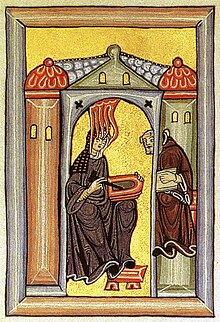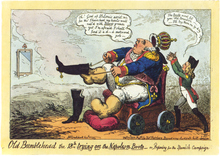


Bear's grease was a popular treatment for men with hair loss from at least as early as 1653 until about the First World War. The myth of its effectiveness is based on a belief that as bears are very hairy, their fat would assist hair growth in others. Nicholas Culpeper, the English botanist and herbalist wrote in 1653, in his The Physician's Library, "Bears Grease staies the falling off of the hair." Hildegard of Bingen (1098–1179), Benedictine mystic, composer and woman of letters, also recommended the use of the substance in her Physica (repeated in her Causae et Curae). A number of cosmetics companies sold bear's grease, and it was a trademark of Atkinsons of London, who sold "Bears Grease Pomade". In the early 1880s in Arkansas, an ell of bear grease, formed from the hide from the head and neck of a deer, was a standard medium of exchange.
Preparation
Bear's grease was made from the fat of the brown bear mixed with beef marrow and a perfume to disguise the smell. Before the start of the twentieth century, manufacturers were substituting pig, veal, suet, lard and beef marrow fat for bear's fat as the demand exceeded the available supply of genuine bear's fat. To these substitutes they added lavender, thyme, rose essence, or oil of bitter almonds for perfume. A green dye was added for the sake of appearances.
It was speculated that 99% of "bear grease" in 1850s England actually contained pig fat, and that unscrupulous manufacturers would keep a bear skin which they would occasionally attach to a dead pig carcass. The purpose of this carcass was just for display to convince their customers that they sold genuine bear grease.
Europe
The general public believed that grease from Russian bears was the best available. In the 1823 cartoon by George Cruikshank on the right, reference is made to "heels well rub'd with bears grease" (by which Russian support is meant). The French King Louis XVIII is unable to put on Napoleon II's boots, and Napoleon's son stands ready to catch the Bourbon crown should it fall.
Professor John Strachan in his book, Advertising and Satirical Culture in the Romantic Period notes that Atkinsons of London were best known for their bear's grease product, which remained in production until after the First World War. Atkinsons' logo was a chained bear, and this was heavily featured in their advertising. The claim that bear's grease could facilitate the regrowth of hair for bald men, was made by Atkinsons and others.
Among the members of the Ursari community, a group of nomadic Romani bear trainers, who manufactured objects of bone, it became widespread to treat the material with bear fat, a luxury good which, they believed, helped make the products in question more durable. The fat was also being sold to Romanians as medicine to combat rheumatism and skeletal disorders, together with bear hairs that were a popular amulet.
Native American use
The use of bear's grease among the Native Americans on their hair to make it shinier was widespread. Other popular substances included deer marrow and raccoon fat. In the Northeast tribes of the Sauk, Huron, and Delaware, the daily use of bear grease on their hair was popular among both men and women. Men in the Dakota Sioux and Crow tribes also regularly used bear's grease. Benjamin West, who was one of the early American fine artists, said he was first taught how to make paint as a child by a Native American friend who showed him how paint could be made by mixing clay with bear grease.
References
- ^ "Developing Treatments" (PDF). Museum of the Royal Pharmaceutical Society. Retrieved 27 June 2014.
- von Bingen, Hildegard. (1998). Physica. Translated by Priscilla Throop. Rochester: Healing Arts Press. p. 209. ISBN 978-1-59477-775-2.
- Smith, KG, Clark, JD, Gipson, PS (1990). History of black bears in Arkansas: over-exploitation, near elimination, and successful reintroduction (PDF). Proceedings of the Tenth Eastern Workshop on Black Bear Restoration and Management. 10:5–14.
- ^ Wood, J.G. (1855). Animal Traits & Characteristics; or, Sketches and Anecdotes of Animal Life. Second series, new edition. London: Routhedge. p. "Swine". 203.
- Crellin, John K. (1994). Home Medicine: The Newfoundland Experience. Montreal: McGill-Queen's University Press. p. 88. ISBN 978-0-7735-1197-2.
- "Old Bumblehead the 18th trying on the Napoleon Boots". BritishMuseum.org. Retrieved 31 July 2014.
- ^ Strachan, John (2007). Advertising and Satirical Culture in the Romantic Period (1st ed.). Cambridge University Press. p. 213. ISBN 978-0521293068.
- Strachan, John (2007). Advertising and Satirical Culture in the Romantic Period. Cambridge University Press. p. 107. ISBN 9781139468848.
- (in Romanian) Delia Grigore, Curs de antropologie şi folclor rrom Archived 23 April 2008 at the Wayback Machine, hosted by Romanothan, retrieved 24 June 2007
- (in Romanian) Eugen Şendrea, "Distracţii de tîrgoveţi", in Ziarul de Bacău, 26 May 2007; retrieved 24 June 2007
- "Bear Grease". Fashion Encyclopedia. Retrieved 27 June 2014.
- Music and Art: West and Antes Archived 10 August 2014 at the Wayback Machine, Cathy Fuller, WGBH, 2014. Retrieved 28 June 2014.